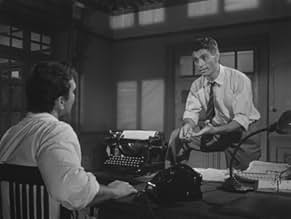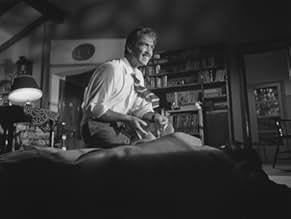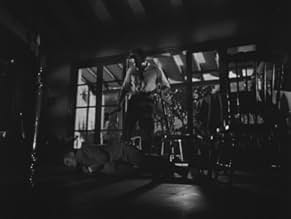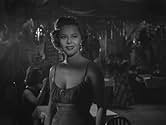Añade un argumento en tu idiomaA washed up reporter teams up with an immigrant from Hungary to start a fake journalism by correspondence school.A washed up reporter teams up with an immigrant from Hungary to start a fake journalism by correspondence school.A washed up reporter teams up with an immigrant from Hungary to start a fake journalism by correspondence school.
- Dirección
- Guión
- Reparto principal
- Premios
- 2 premios en total
Otto Webber
- Noriega
- (as Otto Weber)
George Hilton
- Hombre en redacción
- (as Jorge Hilton)
Reseñas destacadas
THE BITTER STEMS is a 1956 Argentine Film Noir and is one of two new releases from Flicker Alley and the Film Noir Foundation that showcase two "lost" movies from 1950s Argentina. It was based on a best selling Argentine novel and is on AMERICAN CINEMATOGRAPHER's list of the 100 Best Photographed Films of all time. The cinematographer, Ricardo Younis, was a pupil of the legendary Gregg Toland (CITIZEN KANE) while Fernando Ayala was emerging as one of Argentina's top directors. After being acclaimed on its initial release, it disappeared for many years before being discovered at a private collector's home. Restoration was done at the UCLA Film & Television Archive.
The story concerns a disillusioned journalist (Carlos Cores) who joins forces with a Hungarian immigrant (Vassili Lambrinos) to create a fake journalism correspondence school so the Hungarian can bring his family to Argentina. It all starts well with the money rolling in and 2/3 going to bring the family over but soon the journalist thinks he is being cheated after the appearance of a woman who is not a family member. It is then that he takes matters into his own hands with tragic results. In addition to solid performances and moody photography, BITTER STEMS features an early score from celebrated composer Astor Piazzola.
Thanks once again to Flicker Alley for continuing their ongoing Film Noir Series in partnership with "Noircheologist" Eddie Muller and to his Film Nor Foundation for rescuing THE BITTER STEMS from oblivion. The DVD/Blu Ray combo comes with a 23 page booklet that is loaded with photos and information. Other extras include a filmed introduction on the movie with Muller, a conversation with Argentine archivist Fernando Martin Pena, and a profile of composer Astor Piazzola. Finally there is an optional commentary from film historian Imogen Sara Smith. An absolute must have for fans of Film Noir...For more reviews visit The Capsule Critic.
The story concerns a disillusioned journalist (Carlos Cores) who joins forces with a Hungarian immigrant (Vassili Lambrinos) to create a fake journalism correspondence school so the Hungarian can bring his family to Argentina. It all starts well with the money rolling in and 2/3 going to bring the family over but soon the journalist thinks he is being cheated after the appearance of a woman who is not a family member. It is then that he takes matters into his own hands with tragic results. In addition to solid performances and moody photography, BITTER STEMS features an early score from celebrated composer Astor Piazzola.
Thanks once again to Flicker Alley for continuing their ongoing Film Noir Series in partnership with "Noircheologist" Eddie Muller and to his Film Nor Foundation for rescuing THE BITTER STEMS from oblivion. The DVD/Blu Ray combo comes with a 23 page booklet that is loaded with photos and information. Other extras include a filmed introduction on the movie with Muller, a conversation with Argentine archivist Fernando Martin Pena, and a profile of composer Astor Piazzola. Finally there is an optional commentary from film historian Imogen Sara Smith. An absolute must have for fans of Film Noir...For more reviews visit The Capsule Critic.
The Argentinian movie Los tallos amargos (1956) was directed by Fernando Ayala.
Carlos Cores portrays a journalist who forms an unlikely alliance with a Hungarian immigrant, played by Vassili Lambrinos. They open a fraudulent journalism correspondence school. All goes well until mistrust and jealousy intrude.
The acting in the movie is outstanding, and we are treated to a film score by the great Argentinian composer Astor Piazzolla.
We saw this movie at the wonderful Dryden Theatre at the George Eastman Museum in Rochester. Congratulations to the Dryden for screening this film in its original 35mm format. Los tallos amargos was considered lost until a 35mm negative was found and restored by the UCLA Film & Television Archive.
This movie might not be for everyone, but if you love film noir, this is the movie for you.
The acting in the movie is outstanding, and we are treated to a film score by the great Argentinian composer Astor Piazzolla.
We saw this movie at the wonderful Dryden Theatre at the George Eastman Museum in Rochester. Congratulations to the Dryden for screening this film in its original 35mm format. Los tallos amargos was considered lost until a 35mm negative was found and restored by the UCLA Film & Television Archive.
This movie might not be for everyone, but if you love film noir, this is the movie for you.
"And we decided to celebrate our end like the doomed in the movies do."
I loved the look and feel of this Argentinian noir, with its flashbacks, surreal dream sequences, and segues into the inner thoughts of its main character. Instead of a femme fatale we get a tragic figure (Aída Luz), and instead of everything coming apart because of a con game, we get drama out of misunderstanding and paranoia. These are basically good people, driven to dark places by economic desperation, with the post-war conditions in Europe looming as a distant backdrop. I wasn't completely sure about the ending, as the digging wouldn't have to be too deep and the guy should have known it (being vague here on purpose), but I loved how brutally grim it was. Overall, a very satisfying film.
I loved the look and feel of this Argentinian noir, with its flashbacks, surreal dream sequences, and segues into the inner thoughts of its main character. Instead of a femme fatale we get a tragic figure (Aída Luz), and instead of everything coming apart because of a con game, we get drama out of misunderstanding and paranoia. These are basically good people, driven to dark places by economic desperation, with the post-war conditions in Europe looming as a distant backdrop. I wasn't completely sure about the ending, as the digging wouldn't have to be too deep and the guy should have known it (being vague here on purpose), but I loved how brutally grim it was. Overall, a very satisfying film.
"Los tallos amargos" is a great example of film noir released out of USA. Following the tradition of classic Hollywood (the most brillant time in the history of cinema), this picture tell us the story of a poor journalist who, trying to make easy money, begins to work with an hungarian inmigrant. They start a fake journalism school and soon their pockets are full of dirty money. When the journalist begins to have suspects on your partner, the plot will become most than interesting. A perfect movie, a very good story. A picture that looks like any american film of that time. 9 out of 10.
EXTRA: When the A.F.I. chose the 100 bests cinematography of all time, this argentine movie was in the list among titles like "Citizen Kane" (!)
EXTRA: When the A.F.I. chose the 100 bests cinematography of all time, this argentine movie was in the list among titles like "Citizen Kane" (!)
There are several twists and turns in this film, so you'll definitely cheat yourself if you read any reviews warning of spoilers.
Thanks to the Film Noir Foundation and UCLA, the restored version aired on TCM's Noir Alley hosted by Eddie Mueller. If you can catch his intro and outro, you'll learn some interesting things, such as the original novel was awarded a very prestigious Argentinian award as was the film itself, the score is by one of Argentina's most celebrated composers, and one of South America's most popular, if not most popular, female actors of the time has a small but important role.
There's all kinds of noir style going on, but there's also echoes of Edgar Allan Poe's use of concise storytelling, paranoia, and the concept of justice as an archetype. The acting is wonderful, and the cinematography is stunning. The musical score is all over the place, but it honestly works.
A must for noir junkies.
Thanks to the Film Noir Foundation and UCLA, the restored version aired on TCM's Noir Alley hosted by Eddie Mueller. If you can catch his intro and outro, you'll learn some interesting things, such as the original novel was awarded a very prestigious Argentinian award as was the film itself, the score is by one of Argentina's most celebrated composers, and one of South America's most popular, if not most popular, female actors of the time has a small but important role.
There's all kinds of noir style going on, but there's also echoes of Edgar Allan Poe's use of concise storytelling, paranoia, and the concept of justice as an archetype. The acting is wonderful, and the cinematography is stunning. The musical score is all over the place, but it honestly works.
A must for noir junkies.
¿Sabías que...?
- CuriosidadesAs discussed on TCM's Noir Alley by host Eddie Muller in July 2021, a screening of the restored 35mm print of this film was held on behalf of the Film Noir Foundation at the Museum of Modern Art (MoMA) in New York City in February 2016, and shockingly in attendance was 90 year-old Vassili Lambrinos, who, after years of living in various parts of the globe, was living just a few blocks from MoMA. Lambrinos had never seen the film on the big screen nor with an audience before that screening, having seen the film only in an editing room before then.
- Citas
Andreani: You make him infallible. You have an old passion; the need to obey.
Alfredo Gaspar: Passion to obey?
Andreani: To be a subordinate.
- ConexionesReferenced in Preserving Memory: Fernando Martín Peña on Argentine Cinema (2024)
Selecciones populares
Inicia sesión para calificar y añadir a tu lista para recibir recomendaciones personalizadas
- What is the running time of this film ?
Detalles
- Fecha de lanzamiento
- País de origen
- Idioma
- Títulos en diferentes países
- The Bitter Stems
- Localizaciones del rodaje
- Plaza de Mayo, Buenos Aires, Argentina(Gasper and Jarvis walk in the Plaza de Mayo and look at the Cabildo.)
- Empresa productora
- Ver más compañías en los créditos en IMDbPro
- Duración1 hora 30 minutos
- Color
- Mezcla de sonido
- Relación de aspecto
- 1.37 : 1
Contribuir a esta página
Sugerir un cambio o añadir el contenido que falta

Principal laguna de datos
What is the Spanish language plot outline for Los tallos amargos (1956)?
Responde



























